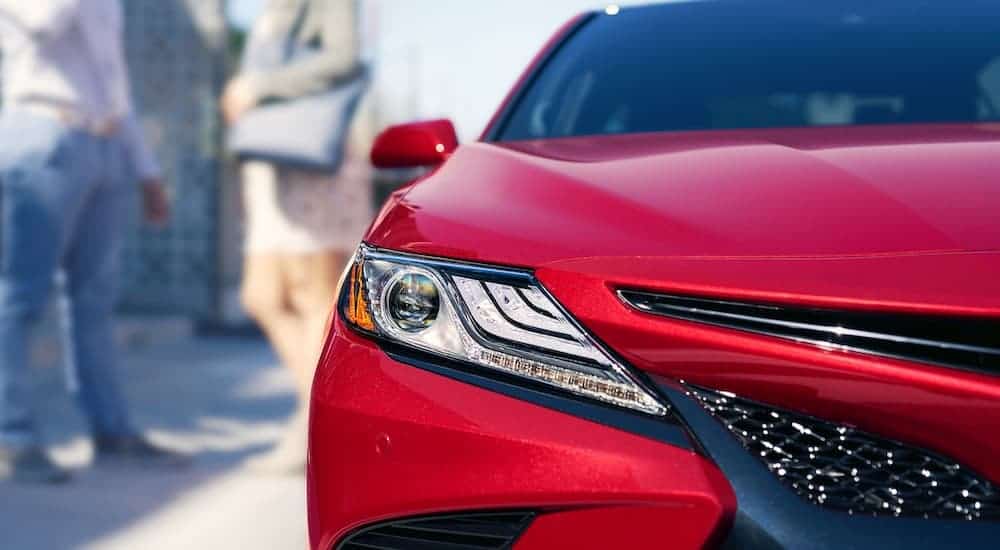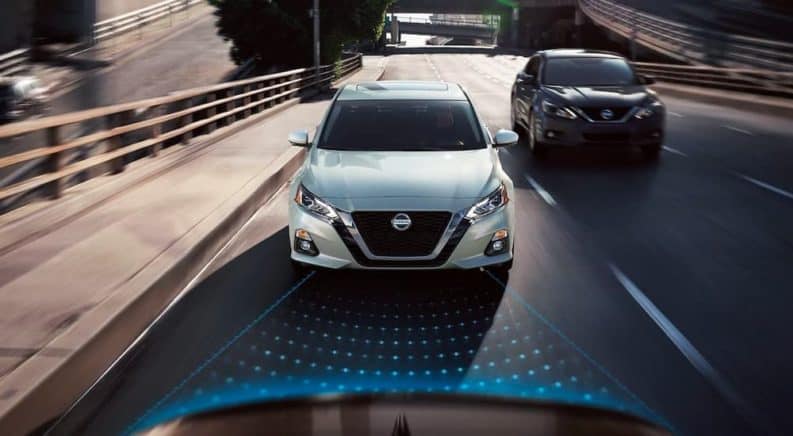With spacious interiors, a respectable amount of horsepower, and numerous safety awards each, the Nissan Altima and the Toyota Camry have dominated the sedan market for decades. In fact, both a used Nissan Altima and a used Toyota Camry hold their value for years. Let’s take a closer look at the Nissan Altima vs Toyota Camry and discover which one reigns supreme. To level the playing field, we’ll look at the 2019 Nissan Altima and the 2019 Toyota Camry specifically.
The Toyota Camry saw a redesign in 2018, while the Nissan Altima was fully redesigned in 2019. Although these stylish sedans share similar features, it’s their differences that make them two of the most wildly popular makes available today. People want these cars because they hold their value and usage over time, but there are some things that make people prefer one over the other.
2019 Nissan Altima
The 2019 Nissan Altima has a respectable 188 horsepower with 180 lb-ft of torque with the base 2.5L engine, a continuously variable transmission, and available all-wheel drive throughout the lineup (front-wheel drive is standard). A turbocharged 2.0-liter, 4-cylinder engine is available for the SR and Platinum trims and will give you a power boost of 248 horsepower and 280 lb-ft of torque.
You’ll find five different trim levels on the 2019 Nissan Altima: the base S, SR, SV, SL, and Platinum. While the base trim lacks some of the luxurious features available on higher trim levels, it still offers excellent value for the price and includes features like Apple CarPlay and a driver condition monitor. You’ll get Safety Shield 360 and a full suite of driving aids on the SV and higher.
The SR, the Altima’s sporty trim, is performance-centric and features the 2.0-liter turbocharged engine, while the SL adds swanky leather seats and navigation features. Platinum is the highest trim level, and it comes packed with all the high-end features any driver could possibly want, including the same turbocharged 2.0-liter, 4-cylinder engine found on the SR. If you want the most luxury from the Nissan Altima line, you should keep your eye out for a used Premium model.

2019 Toyota Camry
With a powerful base 2.5L engine producing 203 horsepower, 184 lb-ft of torque, and front-wheel drive across all trim levels, the 2019 Toyota Camry is a dependable midsize sedan. The Camry was fully redesigned in 2018 with extra safety features, tighter handling, better fuel economy, and a more powerful engine.
Like the 2019 Nissan Altima, the 2019 Camry has five different trim levels: the base L, LE, SE, XLE, and XSE. The base trim isn’t as feature-packed as the higher trim levels, but it offers some incredible features like forward collision warning with pedestrian detection and Apple CarPlay. The LE adds a split-folding rear seat, while the SE offers luxurious synthetic leather seats.
The Camry XLE offers a zippier, 3.5L V6 available engine that generates 301 horsepower and 267 lb-ft of torque. Genuine leather upholstery, wireless device charging, and more come standard. The highest trim level, the XSE, has all the features of the XLE with trim-specific styling and a heads-up display.
Infotainment Features
In today’s fast-paced, technology-centric world, you want a car that offers incredible infotainment features. With many models, the base trim doesn’t offer much more than a set of wheels and an engine. That’s not true of the 2019 Nissan Altima, which provides Apple CarPlay, Android Auto, four USB ports, an 8-inch touchscreen, HD and satellite radio, a stereo with six speakers, and Bluetooth connectivity. These standard infotainment features remain the same across the lineup until the SL, which offers a Bose sound system with nine speakers.
Like the Nissan Altima, the Toyota Camry provides some important infotainment features on its base trim, though they are a little less exciting. You’ll find Apple CarPlay, a single USB port, Bluetooth connectivity, a 7-inch touchscreen, Siri Eyes Free, and a wifi hotspot. Android Auto is notably absent here, one major pitfall of the Camry. The Camry’s infotainment features don’t change until the XLE trim, which adds two USB ports, wireless device charging, an 8-inch touchscreen, plus satellite and HD radio. The XSE trim has the same upgraded infotainment features as the XLE trim, but it adds a JBL stereo system.
Safety Features
Aesthetics and infotainment are undeniably important to most modern drivers, but one factor that trumps all others is safety. After all, many of us have family or friends traveling in our vehicles with us, and we want to keep them safe. Modern technology has advanced safety leaps and bounds beyond what cars used to have, and more and more companies are putting advanced safety tech in even the base models.
In terms of safety features, even the base Nissan Altima S trim outperforms lower trim levels from other manufacturers. The Altima S provides essential features like the Driver Condition Alert System, which uses motion-activated sensors that focus on eye movement and facial features to detect the early warning signs of drowsiness or distraction. If it detects a drowsy driver, the system sends out an audible alert, flashes a coffee cup symbol on the instrument panel, and instructs you to take a break. This is a must-have feature for those who spend a lot of time behind the wheel or find themselves working late hours.
You’ll find a review camera as well as forward collision warning, both of which reduce the possibility of a collision. At the very least, a warning system can help to mitigate some of the damage in the event of an inevitable collision. There’s also automatic emergency braking on the base trim, a feature that’s generally only available on higher trim levels from other manufacturers.
The SR, the Altima’s sporty trim, adds rear cross traffic alert and blind spot monitoring, while the SV tacks on pedestrian detection, lane departure warning, fog lights, and ProPilot Assist with adaptive cruise control. Safety features on the SL remain largely unchanged aside from the addition of traffic sign recognition, and the Platinum trim adds surround-view parking cameras.
When it comes to safety features, the Toyota Camry’s base L trim provides incredible value for money. You’ll gain unique features like lane departure warning and lane keep assist, forward collision warning with pedestrian detection, adaptive cruise control, automatic high-beam headlights, and a rearview camera. The LE adds available rear cross traffic alert and blind spot monitoring. The SE doesn’t bring anything new to the table in terms of safety features, but rear cross traffic alert and blind spot monitoring are available. Those features come standard on the XLE and XSE, but the best bang for your buck is the feature-packed base trim.
Altima or Camry?
When it comes to the battle between the Nissan Altima and the Toyota Camry, the victor is up to you to decide. It all depends on what you’re looking for in a midsize sedan. The Camry has a better selection of engines and power, but the Altima’s base trim offers two features you can’t get on the Camry: Android Auto and the Driver Attention Alert System. If you’re an Android user or spend a lot of time behind the wheel, you may want to opt for the Altima. Either way, you will be getting a reliable vehicle that you can trust, but we think a used Nissan Altima is the way to go.





